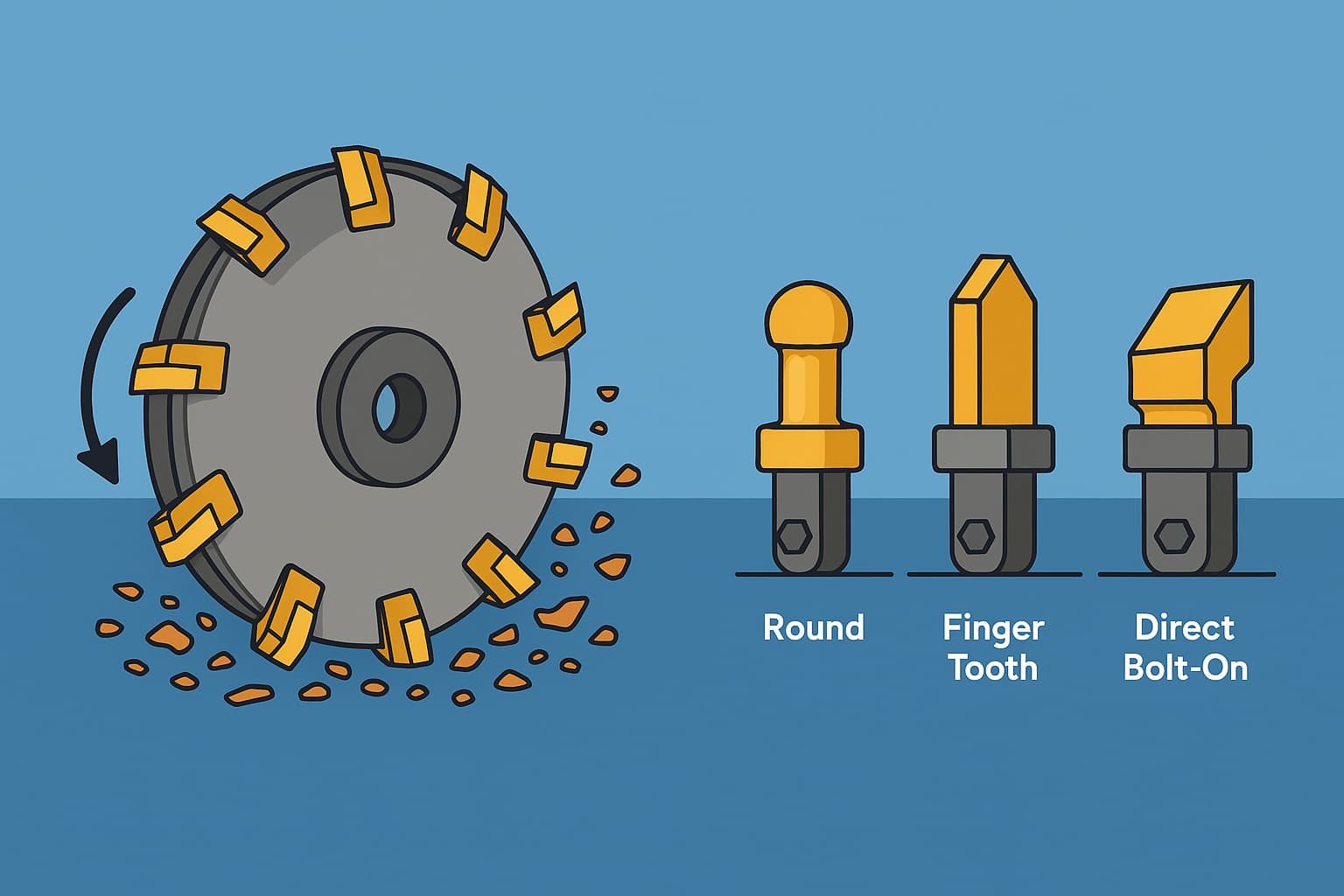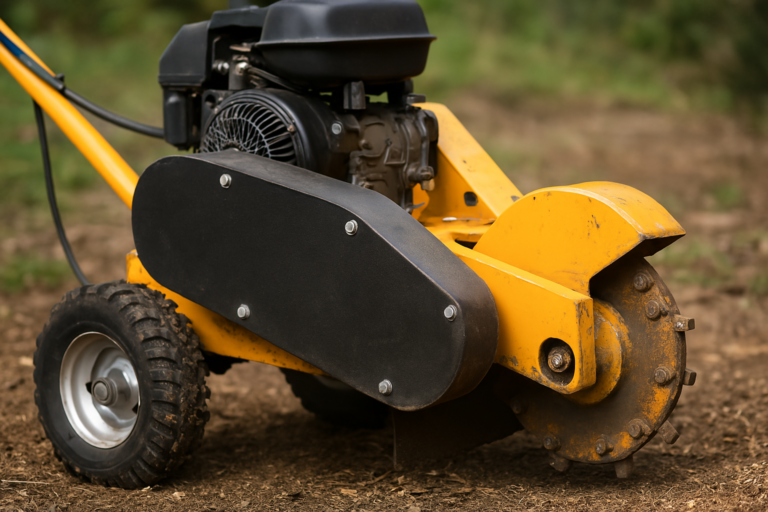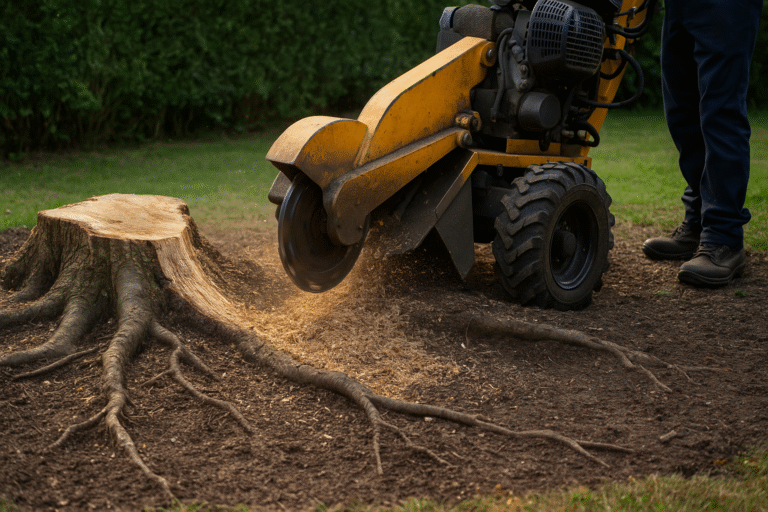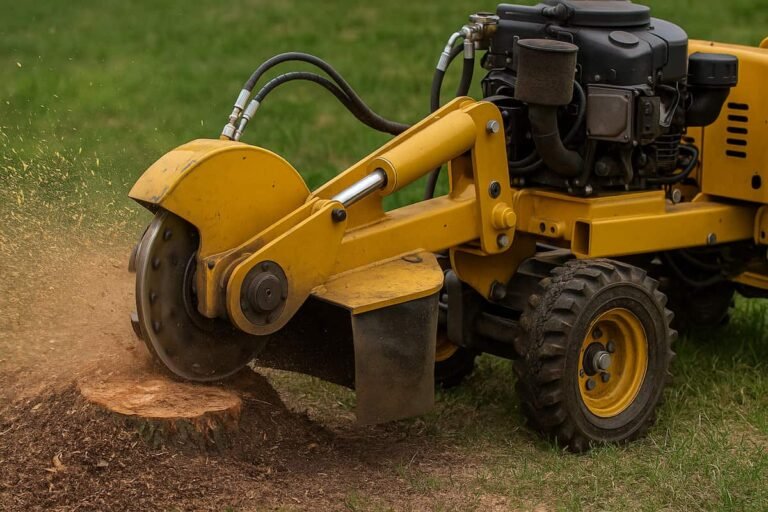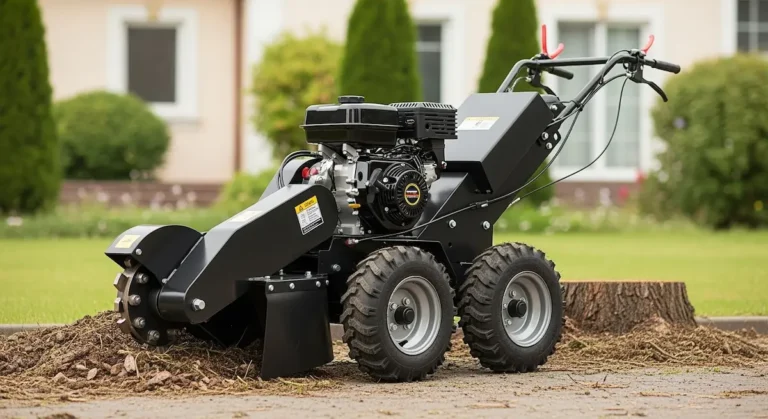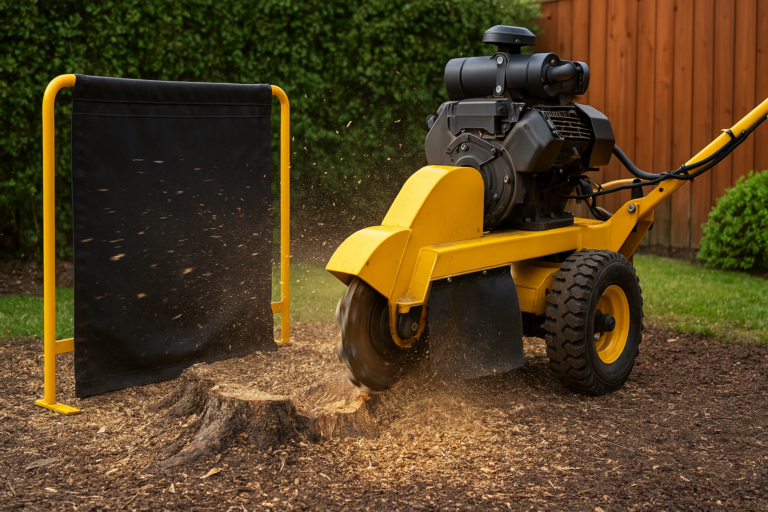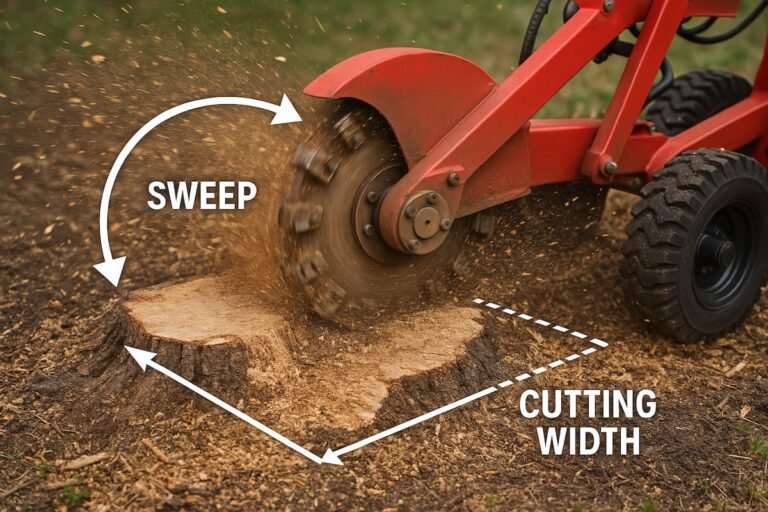Stump Grinder Cutter Wheels Explained: Performance, Types & UK Hire Guide
The cutter wheel is the spinning disc with teeth on a stump grinder.
It does all the hard work of chewing up tree stumps.
Understanding the cutter wheel helps you grind stumps better.
This guide explains everything you need to know.
Stump Grinder Cutter Wheel System Comparison
Key Takeaways
- Rotating Teeth Systems (e.g., Greenteeth®): Score highest in Maintenance Ease and Running Cost Efficiency due to quick rotation to fresh edges and longer overall tooth life. They also offer high Cutting Speed. Initial system conversion costs can be higher.
- Finger Teeth Systems (e.g., Rayco®): Known for very aggressive (High) Cutting Speed. Maintenance is moderately easy, and running costs are generally better than standard teeth but potentially less efficient than rotating systems depending on wear.
- Standard / Direct Bolt-On Systems: Typically have the lowest Initial System Cost. However, they score lower on Cutting Speed, Maintenance Ease (requiring more time for replacement/sharpening), and Running Cost Efficiency (single edge per tooth).
- Overall Trade-off: Modern systems (Rotating, Finger) generally offer better performance and long-term efficiency, especially for frequent use, justifying potentially higher initial costs. Standard systems remain a viable, lower-cost option for occasional use where maintenance time is less critical.
What is a Stump Grinder Cutter Wheel? The Core of the Machine
A stump grinder cutter wheel is a heavy metal disc.
It spins around very fast.
It has super hard teeth attached to it.
These teeth chip away at wood and roots.
The operator moves the spinning wheel over the stump.
It grinds the stump down into small wood chips.
Think of it as the grinder’s mouth and teeth.
It is the most essential part of cutting wood.
| Tooth System | Speed | Ease of Change | Cost Per Edge | Notes |
|---|---|---|---|---|
| Greenteeth® | ✅ Fast | ✅ Very Easy | 💷 Low–Medium | Great for efficiency, multiple sharp edges |
| Rayco Super Tooth® | ✅ Fast | ❌ Slower | 💷 Medium | Aggressive cutter, harder to swap |
| Standard Teeth | ❌ Slower | ❌ Time-consuming | 💷 Low (per tooth) | Needs sharpening, more manual effort |
Identify the Key Parts of a Cutter Wheel
A cutter wheel has several main parts working together.
- Wheel Body: This is a big, heavy steel disc. It gives the wheel weight to cut well.
- Teeth/Cutters: These are the sharp bits that do the cutting. They are often made of a very hard metal called carbide. You can usually replace them.
- Pockets/Holders: These are unique slots on the wheel body. They hold the teeth securely in place. Some are part of the wheel, others bolt on.
- Bolts/Fasteners: Strong bolts hold the teeth or pockets onto the wheel body. They need to be very tight for safety.
Why Your Cutter Wheel Choice Massively Impacts Grinding Results
The type and condition of the cutter wheel matter.
It changes how fast you can grind a stump.
Sharp, good teeth cut quicker, saving time and fuel.
Dull or damaged teeth work slowly and waste fuel.
The cutter wheel affects how smooth the ground looks afterwards.
Good teeth leave fine mulch.
Worn teeth can leave bigger chunks.
It also affects the cost.
Better teeth cost more at first.
But they can save money by lasting longer or working faster.
If you hire a grinder, a good cutter wheel makes the job easier.
A poor cutter wheel makes the job slow and frustrating.
Exploring Different Cutter Wheel and Tooth System Types
Cutter wheels and their teeth have improved over time.
There are a few main types you might see.
Each type has good and bad points.
They differ in speed, how long teeth last, and how easy they are to change.
Modern systems often work much better than older ones.
Assess Rotating Teeth Systems (e.g., Greenteeth®): The Popular Choice.
These systems are pervasive now.
You often see them on YouTube videos about stump grinding.
The teeth are usually round or square.
They have sharp edges all around (often three edges).
When one edge gets blunt, you loosen a bolt.
Then, you turn the tooth to a new, sharp edge.
Finally, you tighten the bolt again.
This is much quicker than changing a whole tooth.
Benefits often mentioned by users:
- Faster: Many users say they grind stumps quicker.
- Convenient: Rotating teeth is easy and saves time. “Love how quick it is to just spin them around to a fresh edge.” (ArboristSite Forum User)
- Longer life per tooth: You get multiple sharp edges from one tooth.
Lots of videos show how easy it is to rotate Greenteeth®.
People on tree expert forums often discuss them.
Many agree they save time and hassle.
Some people debate if they cut faster than other unique teeth.
The initial cost to change to this system can be higher.
You might need new pockets to hold the teeth.
However, many users feel it saves money in the long run.
“Can be pricey upfront to convert, but the time saved and longer life per tooth makes it worth it if you do a lot of stumps.” (Reddit r/Landscaping User)
Evaluate Finger Teeth Systems (e.g., Rayco Super Tooth®)
These are another popular type, especially on Rayco grinders.
They look more like fingers pointing out from the wheel.
They often involve a tooth part and a holder part.
People say they are very aggressive cutters.
They can chew through wood very quickly.
“My Rayco Super Teeth chew through anything, very aggressive… they eat wood fast.” (YouTube Comment on Rayco Grinder Review)
Changing these teeth takes longer than rotating types.
But users like their decisive cutting action.
Rayco often shows off its power in videos.
Understand Standard / Direct Bolt-On Teeth Systems
These are often found on older or smaller grinders.
The teeth bolt straight onto the cutter wheel body.
They can work well.
But changing them can take more time.
Bolts can get stuck or be hard to reach.
Often, these teeth only have one cutting edge.
When they get dull, you need to replace them entirely.
Or you need to take them off and sharpen them.
Sharpening needs special tools and takes time.
“I stick with the basic teeth and sharpen them myself. Takes time, but keeps my costs right down…”” (Tree Buzz Forum User)
These teeth might be cheaper to buy one by one.
But you might spend more time on maintenance.
Recognise the Function of Pocket Systems
Many modern cutter wheels use pockets.
Pockets are holders for the actual cutting of teeth.
The pockets bolt onto the main wheel body.
The teeth then fit into the pockets.
This system makes changing teeth much faster.
You often only need to loosen one bolt per tooth.
This is quicker than unbolting teeth directly from the wheel.
It protects the main wheel body, too.
If you hit something hard, the tooth or pocket might break.
This is often cheaper to fix than damaging the whole wheel.
Consider How Wheel Size and Grinder Power Correlate
Cutter wheels come in different sizes.
Big, powerful stump grinders have large, heavy wheels.
Smaller grinders have smaller, lighter wheels.
The wheel size matches the engine power.
A bigger wheel can cut deeper into the stump.
It can remove more wood with each pass.
This is important when you hire a grinder.
You need a grinder with the right size wheel for your stumps.
A small grinder will take a very long time on a giant stump.
Its small wheel cannot handle the job efficiently.
Always match the grinder size to the stump size.
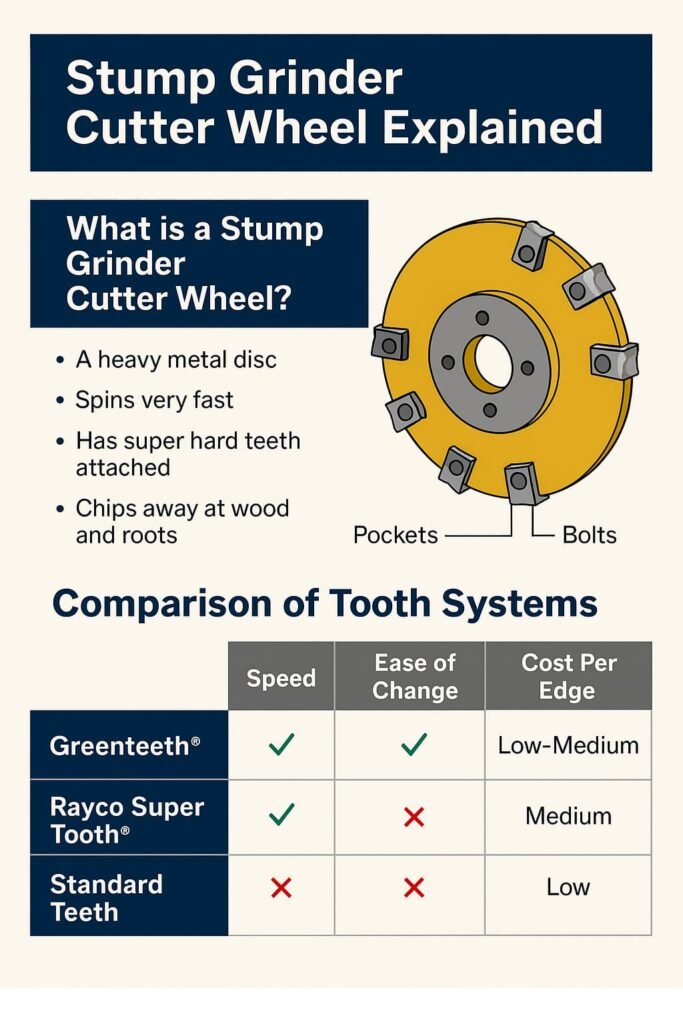
Analysing Key Cutter Wheel Performance Factors
How well a cutter wheel works depends on several things.
These affect how fast the job gets done and how much it costs.
Compare Cutting Speed: How Tooth Design Makes a Difference
Newer tooth designs often cut faster.
Brands like Greenteeth® offer unique shapes (like LoPro).
Manufacturers claim these cut wood more quickly.
Some YouTube videos compare different teeth.
They might show one type of grinding: a stump 15% or 30% faster.
But this changes depending on the wood and the grinder.
Faster cutting is a big deal.
This means less time is spent on each stump.
This saves money on fuel for the grinder.
It saves money on labour time, too.
Hire companies like efficient machines.
Customers hiring grinders want the job done quickly.
Investigate Tooth Lifespan: Expectations vs. Reality
How long do cutter teeth last?
This changes a lot!
Manufacturers don’t usually give exact numbers.
It depends too much on the conditions.
Real users share their experiences online.
Some say they grind dozens of stumps with one set of sharp edges.
This is usually in clean soil with no rocks.
Others say they can wreck teeth on just one stump.
This happens if the ground is very rocky.
Hitting hidden rocks, metal, or concrete instantly ruins teeth.
Rocks are the number one enemy of cutter teeth.
Rotating systems like Greenteeth® help here.
Each tooth has multiple edges (usually 3).
When one edge is dull or chipped, you turn to the next.
This means one tooth lasts three times longer before needing replacement.
But you must rotate them as soon as they get dull.
Example from a user forum (not exact numbers, but typical):
“I probably get about 40-60 medium stumps done using all three edges on my Greenteeth. My soil is mostly clear.””
Compare this to someone with older teeth:
“I must sharpen my standard teeth after every 10 or 15 stumps to keep them cutting well.”
Lifespan depends on the ground and what you hit.
Calculate the True Cost: Initial Investment vs. Running Expenses
Think about the total cost, not just the price of one tooth.
Initial Cost:
- The cutter wheel itself is expensive if you need a whole new one.
- Changing to a system like Greenteeth® might mean buying new pockets, too. This adds to the upfront cost.
- Standard teeth might seem cheaper individually.
Running Cost:
- This is where systems with easy-to-change or rotating teeth save money.
- You spend less time changing teeth. Time is money!
- You get more cutting life from rotating teeth before buying new ones.
- The cost per sharp edge can be lower.
Example Cost (just for illustration):
- One Greenteeth® tooth might cost £7. It gives three sharp edges for £ 2.33 per edge.
- One standard tooth might cost £6. It gives you one sharp edge. Cost per edge = £6. You might also need to pay for sharpening.
People often discuss these costs on forums.
For busy operators, saving time on maintenance is valuable.
It means they can do more jobs per day.
Evaluate Maintenance Time: Swapping vs. Sharpening
How long does it take to get sharp teeth back on the wheel?
Rotating Teeth (like Greenteeth®):
- Videos show this takes maybe 1-2 minutes per tooth.
- You loosen one bolt, turn the tooth, and tighten the bolt. Quick and easy.
Replacing Standard Teeth:
- This can take much longer.
- You should remove several bolts per tooth.
- Bolts can be rusty, stuck, or hard to get to.
- You need the right tools.
Sharpening Standard Teeth:
- You have to remove all the teeth first.
- Then, you need a special grinding machine to sharpen them correctly.
- This takes skill and extra time. Or you pay someone else to do it.
Modern systems save time on maintenance.
Less downtime means the grinder is working more and earning money.
Mastering Essential Cutter Wheel Maintenance and Care
Looking after your cutter wheel is super important.
Good care keeps it working well and safely.
It also saves you money by making parts last longer.
Maintain Sharp Teeth for Peak Performance
Dull teeth are bad news.
They cut very slowly.
They make the grinder engine work much harder.
This uses more fuel.
They leave a messy finish with big wood chunks.
They put more stress on the whole machine.
Check teeth sharpness often, maybe before every job.
Rotate or replace teeth as soon as they get blunt.
“Biggest tip: Check your teeth BEFORE every single job. You never know what you hit last time.”
Conduct Regular Damage Inspections: Spotting Trouble Early
Look closely at the teeth, pockets, and wheel.
Check for:
- Chipped or missing carbide tips on the teeth.
- Cracked teeth.
- Cracked or damaged pockets.
- Bent or broken bolts.
Hitting rocks, roots, or hidden metal is the leading damage cause.
Even small chips can get worse quickly.
A damaged cutter wheel tooth is more likely to break completely.
YouTube has videos showing what happens when wheels fail – it’s dangerous!
Ensure Correct Bolt Torque: A Critical Safety Check
The bolts holding the teeth or pockets must be tight.
Precisely the right tightness (torque).
Loose teeth are extremely dangerous.
A tooth flying off a spinning wheel can kill someone.
It can also smash the grinder guards and cause costly damage.
Too tight is also bad.
Over-tightening bolts can stretch or break them.
It can also damage the pocket or the wheel itself.
Always use a torque wrench.
Follow the manufacturer’s exact torque settings.
Check bolt torque regularly. Some operators check daily.
This is the most crucial safety check.
Hire companies should always check torque before renting out a machine.
Quick Scan: Common Cutter Wheel Problems & Solutions
Problem: Dull Teeth
- Symptom: Slow grinding, engine straining, rough finish.
- Solution: Rotate teeth (if possible) or replace them immediately. Check sharpness often.
Problem: Chipped / Broken Teeth
- Symptoms: Vibration, poor cutting, visible damage. Often caused by hitting rocks/debris.
- Solution: Replace damaged teeth right away. Inspect pockets and bolts for related damage. Avoid grinding near known rocks.
Problem: Loose Teeth / Bolts
- Symptom: Unusual noise, vibration, potentially catastrophic failure (tooth flying off).
- Solution: Stop immediately! Use a torque wrench to check all bolt torques, following the manufacturer’s specifications. Check torque regularly.
Problem: Hitting Rocks / Debris
- Symptom: Sudden impact noise, instant tooth damage, possible wheel damage.
- Solution: Grind carefully, especially near ground level or in unknown soil. Probe the area first, if possible. Accept that some damage is inevitable in rocky areas—factor potential tooth damage into job quotes for rocky sites.
Cutter Wheels in Action: Real-World Examples and Operator Tips
Hearing from people who use these machines gives excellent insight.
Learn from Operator Experiences and Testimonials
Here is what real users say (summarised from forums and video comments):
About Greenteeth®:
- “Massive difference in speed… especially cleaning out the bottom of the hole.”
- “Saves me so much time compared to swapping out the old carbides.”
- “Worth the money if you do lots of stumps because of time saved.”
About Rayco Super Teeth®:
- “Chew through anything, very aggressive.”
- “Maybe not as easy to swap… but they eat wood fast.”
About Standard Teeth:
- “I sharpen them myself… keeps my costs down as I don’t do high volume.”
General Tips from Experienced Users:
- “Always ask about the soil when quoting. Rocks are your enemy.”
- “Factor in potential extra tooth wear for rocky sites.”
- “Make sure the hiring company gives you a grinder with sharp teeth! Makes a HUGE difference.”
Understand the Impact of Ground Conditions (Rocks!)
This comes up again and again in user discussions.
Grinding stumps in rocky soil is tough on teeth.
Urban areas can hide old pipes, bricks, or concrete under the soil.
Even the best, most expensive teeth can break quickly if you hit something hard.
People share stories on forums like Reddit (r/Arborists).
They talk about replacing teeth much more often in bad ground conditions.
This is important for customers hiring grinders, too.
The state of your garden soil affects how long the job takes.
It also affects whether you face extra charges for damaged teeth (check the hire agreement).
Essential Checks When Hiring a Stump Grinder in the UK
Pay attention to the cutter wheel if you plan to hire a stump grinder.
It will make your job much easier or harder.
Ask About the Cutter System and Tooth Condition
Ask the hire company what type of teeth are on the grinder.
Modern systems like Greenteeth® are often easier for occasional users.
Most importantly, check that the teeth are sharp when you collect the machine.
Look at them closely.
If they look dull, worn, or chipped, point it out.
Ask for sharp teeth.
Using a grinder with dull teeth is slow and hard work.
It wastes your time and money.
Clarify Your Liability for Damaged Cutter Teeth
Read the hire agreement carefully.
Understand who pays if teeth get damaged or broken during your hire.
Hitting rocks or debris is common.
Teeth are expensive to replace.
Some agreements might charge you for each broken tooth.
Knowing the rules beforehand prevents surprises later.
Also, make sure the grinder size matches your job.
Tell the hire company about the size and number of stumps.
They can recommend the right machine with the right size cutter wheel.
Conclusion: Choosing the Right Cutter Wheel Matters for Your Stump Grinding Success
The cutter wheel is the heart of the stump grinder.
Its type and condition control how well the machine works.
Modern teeth systems often cut faster and save maintenance time.
But all teeth wear out, especially if you hit rocks.
Looking after the wheel and teeth is vital for safety and cost.
Always check sharpness and bolt tightness.
When hiring, check the teeth are sharp.
Understand the rules about damage.
Choose the right size grinder for your stumps.
Paying attention to the cutter wheel helps you grind stumps efficiently and safely.
Ready to tackle those stumps?
Check out our UK stump grinder hire listings to find the right machine near you!

